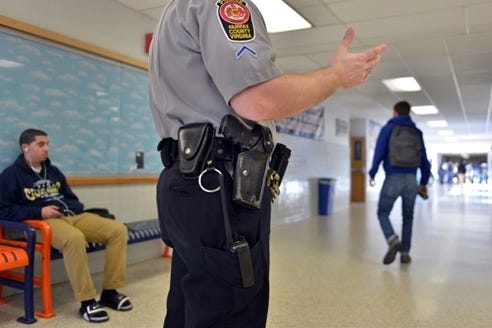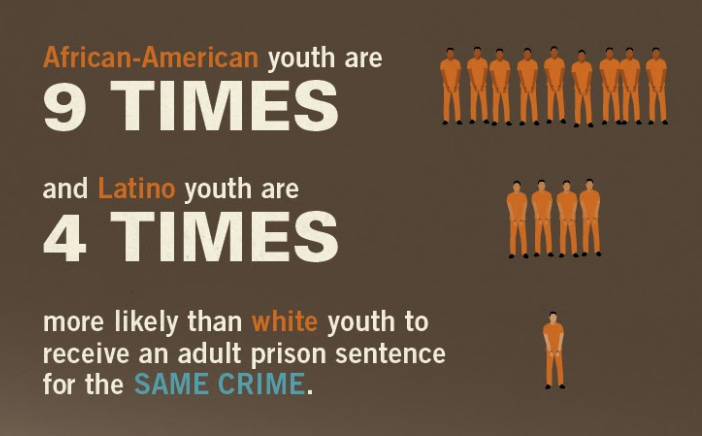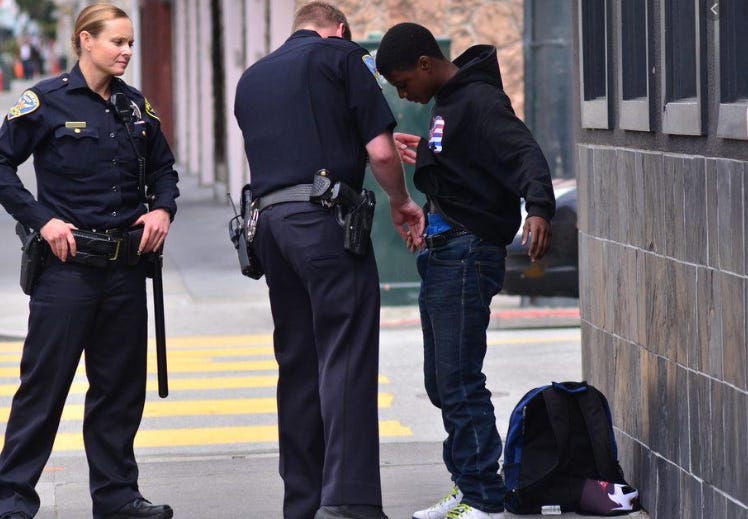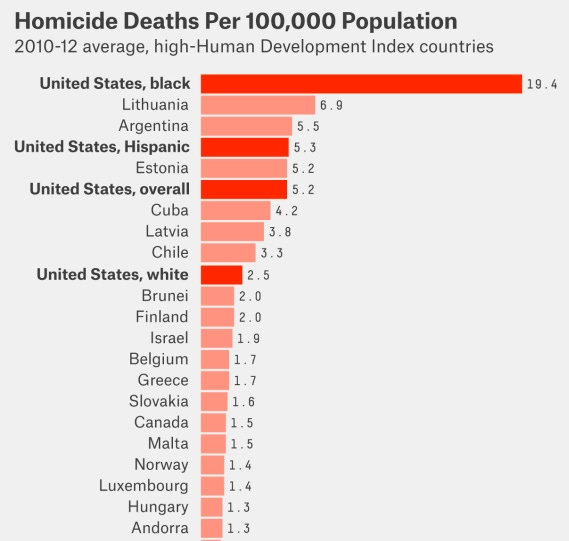We are living through something, and I’m not sure anyone knows what it really is yet, or what things will look like on the other side. I am going to spend the next few newsletters talking about the systems fueling the anger - the ways American society is rigged against African Americans from birth. I will be sharing some of the stories that have helped me better understand racial inequality and systemic bias. It is by no means a comprehensive look, but I hope it helps provide some additional context.
School Discipline

America points to its public education system as an example of our exceptionalism - in the whitewashed version of the American Dream, everyone has access to education, and anyone can achieve success with hard work. The reality for black children, however, is quite different.
It starts with school discipline. There are many studies showing black students are far more likely to be suspended, starting as early as middle school. Researchers call it the “school to prison pipeline”. Schools adopted strict policies against violence in the 1990s, but it soon spiraled out of control, and punishments were handed out for minor behavior infractions:
At the same time as zero-tolerance policies for violence were growing, school districts adopted their own version of the broken windows theory of policing. The broken windows theory emphasizes the importance of cracking down on small offenses in order to make residents feel safer and discourage more serious crimes; in schools, it translated into more suspensions for offenses that previously hadn't warranted them — talking back to teachers, skipping class, or being otherwise disobedient or disruptive.
Punishing black children with needless suspensions means they fall behind on classwork, their grades suffer, and their chance of being selected by good high schools and colleges is diminished.
Another, more insidious development in the way American schools are being run is the proliferation of “resource” officers - called SROs - in schools, many of whom are police. They were supposed to ensure the safety of students, but it quickly spiraled out of control:
About 92,000 students were arrested in school during the 2011-2012 school year, according to US Department of Education statistics. And most of those are low-level violations: 74 percent of arrests in New York City public schools in 2012, according to a report published by the state courts, were for misdemeanors or civil violations.
[…]
A report by the Justice Policy Institute found that, even controlling for a school district's poverty level, schools with officers had five times as many arrests for "disorderly conduct" as schools without them.
Now, the school to prison pipeline becomes explicit, as schools outsource their discipline to the police and court system:
When a school allows a School Resource Officer to arrest a student — or, less drastically and more commonly, refers a student to law enforcement or juvenile court as a form of discipline — they're turning that student over to the juvenile justice system. That makes it that much easier for a student to get a juvenile record (so even if punishment for a first offense is light, punishment for a second offense is likely to be much harsher).
Having an arrest record as a child when you’ve likely been engaging in mild mischief is a dramatic escalation of consequences, and is far more likely to happen to black children. Not to mention, children who receive such harsh discipline may not finish school at all:
…[a] Texas study found that students who had been suspended or expelled were twice as likely to drop out compared to students with similar characteristics at similar schools who had not been suspended.
Juvenile Justice

Once black youth are put into the juvenile justice system, things only get worse. The Sentencing Project lays it out:
As of 2013, black juveniles were more than four times as likely to be committed as white juveniles
[…]
In 2003, African American youth were 3.7 times as likely as white youth to be committed; by 2013, that ratio had grown to 4.3, a 15 percent increase in the disparity. Between 2003 and 2013, 33 states and the District of Columbia had higher black/white commitment disparities than 10 years before
Despite an overall decline in the rate of kids being put in juvenile detention, African American youth were now more likely to be put into the system.
Once inside the system, prosecutors and judges are more likely to punish black children harshly compared to their white peers. They are many times more likely to be tried as adults:
In 2014, Black youth were 14% of the youth population nationally, but 52.5% of the youth transferred to adult court by juvenile court judges, the highest percentage of Black youth transferred in nearly thirty years of data collection.
[…]
12 states and DC allow prosecutors to direct file youth to adult court without a juvenile court judge reviewing the decision. As a result in 2016, Florida, the state with the highest number of direct file transfers publicly reported in the country, direct filed 1,084 youth, 67.7% were black youth even though black youth were only 20% of the youth population.
Whether it’s judges or prosecutors making the decisions, black youth are disproportionately affected by a racially biased juvenile justice system. If that wasn’t enough, sometimes judges are literally being paid to put kids away:
One of the biggest corruption scandals to hit America's juvenile justice system started to unfold in 2007, when parents in a central Pennsylvania county began to complain that their children had been tossed into for-profit youth centers without a lawyer to represent them.
Over the past eight years, the kickback scheme, known as "kids for cash," has resulted in prison terms for two Luzerne County judges and two businessmen — and convictions of thousands of juveniles have been tossed out.
Yes, two judges were being paid by a private prison company owner to funnel kids to his facilities for years. This is an extreme example, but it highlights just how unfair the juvenile justice system can be, and how little scrutiny it receives. Every state has its own laws and procedures for juvenile court, and the rights of minors are more loosely defined than adults.
It is much easier for black children to end up behind bars due to racial bias in school discipline and the justice system. Entering adulthood with a juvenile record or without a high school degree puts them at a massive disadvantage, before they’ve had a chance to make a single decision as an adult.
Policing the Street

Even if black youth are able to stay out of trouble in school, they are likely to encounter police elsewhere. This is due to the systematic over-policing of black neighborhoods.
Modern policing strategies have reinforced a vicious cycle of police presence in minority neighborhoods, because their predictive models say crime is more likely to occur there. The officers who show up harass the local populace, arresting and citing them for petty crimes. Crime stats go up, the computers send more officers there, et cetera. It’s been going on for decades - and it is part of the reason black youth are more than twice as likely to be arrested as their white peers.
The “broken windows” policing method New York City cops enforced for twenty years overwhelmingly targeted minority communities. The perceived effectiveness of the city’s CompStat program spawned dozens of other “tech” driven policing systems - the crime rate in New York has fallen for years, though it’s also fallen all over the country. But does more policing lead to less crime?
Ironically, New York City got a chance to test this hypothesis in 2014, when the NYPD went on an unofficial strike to punish the mayor for criticizing the police department’s handling of the Eric Garner murder - he was choked to death by police, on tape.
Anyhow, the NYPD brass told its officers to stop working minor complaints, thinking it would lead to a surge in crime and prove the city needed its cops. And then the opposite happened:
If more policing reduces crime, then we would expect less policing should lead to more crime.
But in fact we find the opposite. Civilian complaints of major crimes — murder, rape, felony assault, burglary and grand larceny — actually declined during the slowdown.
How about that! As we’re witnessing right now, police departments - the NYPD in particular - operate as extrajudicial bodies, answerable to no one, and inclined to punish anyone who offers even mild criticism. It took a series of lawsuits to get them to stop their racist profiling, and it’s unclear whether any of it had a real impact on a crime rate that was declining regardless.
What it did do was create hundreds of thousands of encounters between the police and black citizens. The impact it had on their lives and futures is impossible to measure, but in New York and all over the country, African Americans are far more likely to have been involved in the criminal justice system by the time they are adults.
Unsolved Murders

The cruel irony is that while black neighborhoods receive inordinate attention from the police for low level crimes, they are also hot spots of violence because the police are unable to solve murders in those same neighborhoods.
Taking a small step back, I want to address a common misconception in white America - that our country is more dangerous than other developed nations, because we have a higher per capita murder rate. This is true on it’s face, but the numbers tell another story: it is very dangerous to be a black male in America, and not at all dangerous to be a white person.
A 2015 analysis by Nate Silver tells the tale:
From 2010 through 2012, the annual rate of homicide deaths among non-Hispanic white Americans was 2.5 per 100,000 persons, meaning that about one in every 40,000 white Americans is a homicide victim each year. By comparison, the rate of homicide deaths among non-Hispanic black Americans is 19.4 per 100,000 persons, or about 1 in 5,000 people per year.
Black Americans are almost eight times as likely as white ones to be homicide victims, in other words.
So for white Americans, the homicide death rate is not so much of an outlier. It’s only modestly higher than in Finland, Belgium or Greece, for instance, and lower than in Chile or Latvia.
White Americans, in other words, are about as safe here as they are in Finland or Belgium. Black Americans, however, are living in the equivalent of Mexico or Brazil. The chart is stunning:

The fantastic book Ghettoside by Jill Leovy focuses on the history of policing murders in South Central Los Angeles - how detectives avoided the area, and the unending strings of reprisal killings in the 1990s and 2000s.
What are reprisal killings? In this context, they are revenge murders in neighborhoods where police are unable or unwilling to solve crimes, leading people to take matters into their own hands. In black neighborhoods - where most murders go unsolved - they are far more common. But it has little to do with skin color, and everything to do with how the police investigate these crimes. It is a cycle of violence perpetuated by a broken system.
In 2018, the Washington Post did a detailed analysis of the places where murders are most likely to go unsolved:
The overall homicide arrest rate in the 50 cities is 49 percent, but in these areas of impunity, police make arrests less than 33 percent of the time. Despite a nationwide drop in violence to historic lows, 34 of the 50 cities have a lower homicide arrest rate now than a decade ago.
Some cities, such as Baltimore and Chicago, solve so few homicides that vast areas stretching for miles experience hundreds of homicides with virtually no arrests.
Further emphasizing the racial disparity in policing, murders with black victims are far less likely to result in an arrest:
Homicide arrest rates vary widely when examined by the race of the victim: An arrest was made in 63 percent of the killings of white victims, compared with 48 percent of killings of Latino victims and 46 percent of the killings of black victims. Almost all of the low-arrest zones are home primarily to low-income black residents.
A lack of justice or accountability in black communities creates another vicious cycle of violence - one created and perpetuated by police forces who claim they need community help to solve crimes - the same communities they have terrorized for decades.
Cop Stuff
Annie Lowrey writes about the “defund” movement for police reform. A friend of mine sued his city to lift their curfew - and won. Jamelle Bouie on how the police are the rioters. Most police don’t live in the cities they serve.
Tips, protests, and other social uprisings to scammerdarkly@gmail.com
